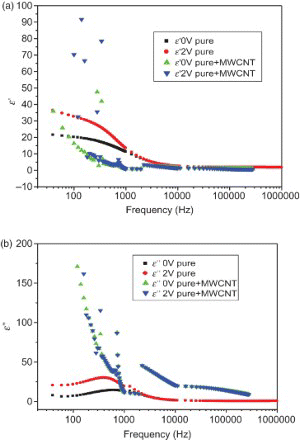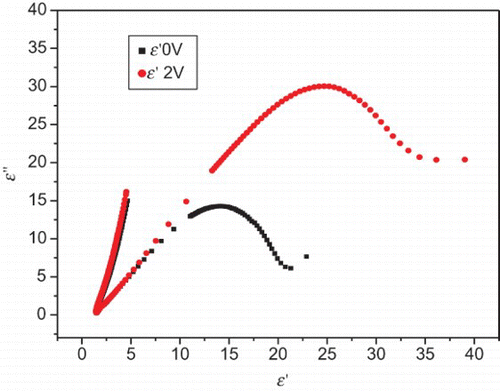Abstract
The dielectric spectra of pure and 0.1% multi-walled-carbon-nanotube-(MWCNT)-doped ferroelectric liquid crystal (FLC) mixture KCFLC10S materials were studied in the 50 Hz to 1 MHz frequency range at different bias voltages. An unusual behavior-increase of ϵ′ with increasing E was observed in both samples. It was found that although the relaxation mode was not observable in the MWCNT-FLC sample, the increased effect of the bias voltage on the FLC with the addition of MWCNTs is clearly visible. A theory is presented to explain this effect of MWCNTs in the FLC material.
Introduction
In 1975, Robert Meyer discovered that the liquid crystalline materials exhibiting the chiral smectic C (SmC*) phase show ferroelectricity. Since then the study of ferroelectric liquid crystals (FLCs) has developed into a rapidly growing multidisciplinary field involving physicists, electrical and computer engineers, and chemists. The problems regarding both the fundamental scientific interest and the practical nature are being addressed [Citation1,Citation2]. These materials were found to be useful for certain applications depending on their parameters, such as their dielectric, electro-optic, and surface properties [Citation3–9]. The improvement of these parameters is always desirable.
Carbon nanotubes (CNTs), on the other hand, are rolled-up sheets of graphene and possess unique electronic and optical properties. The properties of CNTs depend on their alignment, which is controlled by doping in polymers and liquid crystals. The doping of CNTs also enhances the properties of the host material. The dielectric parameters of the liquid crystal material are also expected to be affected by the addition of CNTs.
In this paper, the results of a study on the effect of multi-walled carbon nanotube (MWCNT) inclusion on the dielectric parameters of FLC mixture are presented. The dielectric spectra represent the two relaxation modes in the SmC* phase showing the existence of some low-frequency relaxation mode (LFRM), which dominates with increase in bias. The inclusion of MWCNTs seems to significantly affect the bias dependence of the dielectric behavior.
Experiment
The MWCNTs that were used in the present study were synthesized at the National Physics Laboratory via chemical vapor deposition. The diameters of the synthesized MWCNTs ranged from 30 to 50 nm, with the typical lengths ranging from 0.3 to several μm. The MWCNT-FLC dispersion was prepared by adding a small amount (0.1 wt%) of MWCNTs to the FLC materials, followed by mixing. The liquid crystal (LC) material that was used in this study was the ferroelectric mixture KCFLC10S. The phase sequence of the material is
It has a large spontaneous polarization (23 nc/cm2) and a large tilt angle (22°). Cells 6 μm thick were used in the investigation. These were prepared by rubbing polyvinyl alcohol unidirectionally on indium-tin-oxide-coated glass substrates to obtain planar alignment. The cells were then filled with this material through capillary action at or above the material's isotropic temperature. A well-aligned texture was obtained by cooling down the sample to room temperature using a custom-built temperature controller interfaced to the hot stage. The dielectric parameters were measured in the frequency range of 50 Hz to 1 MHz, using an LCR meter (INSTEK 8110G) interfaced with a computer for further analysis. Calibration with air and benzene enabled the calculation of the absolute value of the dielectric constant from the measured data.
Results and discussion
The frequency dependence of the real and imaginary parts of the dielectric permittivity () of the pure and MWCNT-doped KCFLC10S materials for different bias voltages is shown in (a) and 1(b), respectively. It reflects the dielectric spectrum in the form of absorption (
) ((b)) and dispersion (
) ((a)) curves. For the pure material, it is seen that
shows dispersion at a particular frequency. Saturation in permittivity is observed after this frequency. On the other hand,
shows a peak at this frequency. It is ∼200 Hz at all the bias voltages. It corresponds to the relaxation frequency and is associated with the Goldstone mode (GM). shows the relaxation process in terms of Cole–Cole plots for the pure material. The Cole–Cole plots were observed to be distorted. According to theoretical studies [Citation10], the distortion in the Cole–Cole plots is a consequence of overlapping modes. Thus, it is expected that the relaxation in this study corresponds to the presence of two modes: GM and some other low-frequency relaxation mode (LFRM).
Figure 1. (a). Behavior of the real part of the dielectric permittivity (ϵ′) of the pure and MWCNT-doped KCFLC10S materials with different biasing; (b). Behavior of the imaginary part of the dielectric permittivity (ϵ″) of the pure and MWCNT-doped KCFLC10S materials with different biasing.

(a) and 1(b) also shows that the permittivity increases with an increase in bias voltage. GM, according to the aforementioned theory [Citation11], is suppressed with bias application, thereby decreasing the magnitude of permittivity. Considering this, the increase in complex permittivity with the bias cannot be explained based on GM. Here, some low-frequency contributions to with a relaxation frequency lower than the observable range are considered, which play a decisive role. In FLCs, bias application results in the shift of the relaxation frequency (fr) to higher values [Citation12]. The further consideration herein is based on the fact that fr increases with increasing bias (E) without considering any special type of dependence of fr(E). It shall now be demonstrated that
’s dependence is due to fr(E). Now,
can be roughly described by a Debye relaxator usually expressed by the formula
The effect of MWCNTs on the complex dielectric permittivity of FLCs is also shown in (a) and 1(b) in terms of its frequency dependence at different bias voltages. These graphs show the significant effect of MWCNTs on the dielectric properties of the KCFLC10S material. As observed from the graph, there is no relaxation mode in the MWCNT-doped FLCs in the measured frequency range, but the value of increases with the addition of CNTs due to the dipole–dipole interaction between the FLC and CNT molecules [Citation13]. The relaxations present in the pure FLC mixture appeared to have been suppressed by the addition of MWCNTs due to the masking of GM by the increased value of the
of LFRM. Also, the increase in dielectric permittivity with bias application is much more significant in the case of the doped mixture, as shown in (a) and 1(b). This enhanced effect of bias on dielectric permittivity can be attributed to the fact that in the application of an electric field, torque acts on both the CNT and FLC molecules due to their nontrivial dielectric anisotropies. This results in decreased rotational viscosity, which increases the effect of the biasing field in the CNT-doped sample. The disappearance of the relaxation mode in the CNT-doped sample is also attributed to this increased effect of bias on the MWCNTs-FLC sample. In the MWCNTs-FLC sample, the ωr of the LFRM increased significantly with the bias and hence masked the relaxation of GM. This results in the manifestation of the disappearance of GM.
Conclusions
In summary, the effect of the addition of MWCNTs on the bias dependence of the complex permittivity of a pure FLC material was studied. It was observed that with bias application, the permittivity of both the pure and CNT-doped samples showed an unusual behavior: an increase in with the biasing field. This is attributed to the increases in the ωr of some LFRM,{\newpage} thereby its overlapping with the GM. The distorted shapes of the Cole–Cole plots also confirm the presence of two overlapping modes: the LFRM and GM. It was also observed that doping in MWCNTs enhanced the effect of the bias in the FLC mixture, which resulted in the masking of GM by the LFRM.
Acknowledgements
The authors wish to thank Dr Rajesh K. Mahajan (Principal, JCDAV College, Dasuya) for his support of this project. The financial support provided by the Department of Science and Technology, New Delhi is also gratefully acknowledged.
References
- David M. Walba, in Advances in the Synthesis and Reactivity of Solids, Vol. 1, 173 (1991) JAI Press Ltd. ISBN:1-55938-182-5.
- R.B. Meyer, L. Liebert, L. Strzelecki, and P. Keller, J. de. Phys. Lett. (Paris), 36, L69 (1975). doi: 10.1051/jphyslet:0197500360306900
- L.A Bersnev, L.M Blinov, M.A. Osipov, and S.A. Pikin, Mol. Cyst. Liq. Cryst. 158A, 1 (1988).
- Yasuyuki Kimura and Reinosuke Hayakawa, Jap. J. Appl. Phys. 32, 427 (1993).
- K.K Raina and H.J. Coles, presented at the 9th IEEE Int. Symp. on Appl. of Ferroelectrics, USA, CH3416-50-7803, IEEE, 788 (1995).
- K.K Raina and Jasjit K. Ahuja, Mol. Cryst. Liq. Cryst. 338, 125 (1999).
- N.A Clark and Sven T. Lagerwall, Appl. Phys. Lett. 36, 11 (1980). doi: 10.1063/1.91359
- L.A. Bersnev, V.G. Chigrinov, D.I. Drgachev, E.P. Poshidaev, J. Funfschilling, and M. Schadt, Liq. Cryst. 5, 1171 (1989). doi: 10.1080/02678298908026421
- J. Funfshcilling and M Schadt, J. Appl. Phys. 66, 3877 (1989). doi: 10.1063/1.344452
- Jan. P.F. Lagerwall, Ph. D thesis, Goteborg University, Sweden, 2002.
- S. Wrobel, A.M. Biradar, and W. Haase, Ferroelectrics, 100, 271 (1989). doi: 10.1080/00150198908007922
- J. Pavel, M. Glogarova, and S.S. Bawa, Ferroelectrics, 76, 221 (1987). doi: 10.1080/00150198708009041
- Samriti Khosla., Nitin Sood, Darshan Singh, S.S. Bawa, Liq. Cryst. 39, 1169 (2012) doi: 10.1080/02678292.2012.700077
